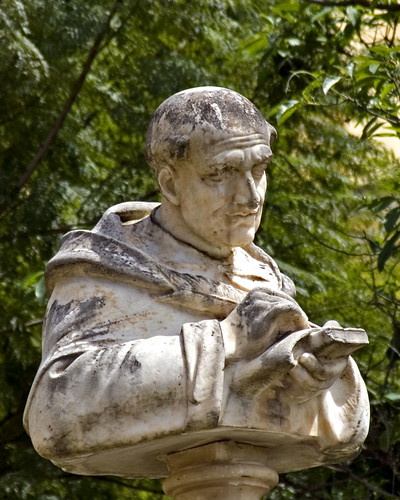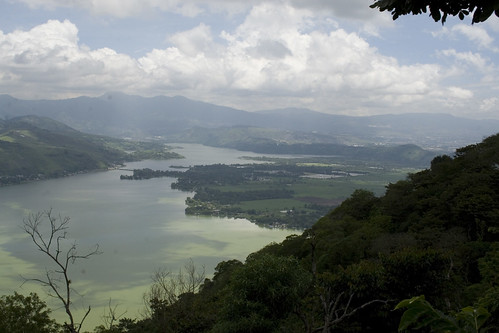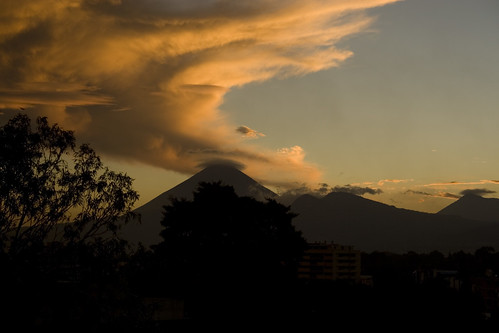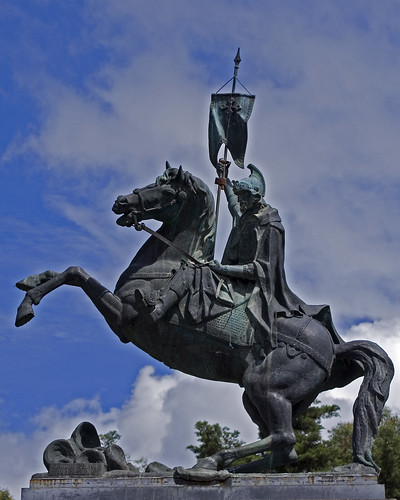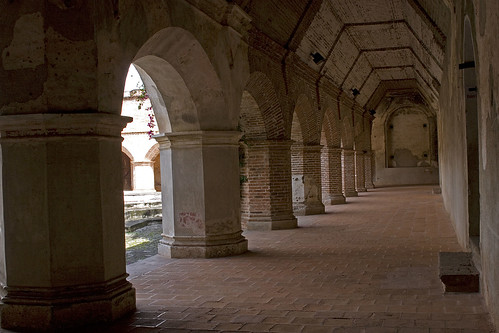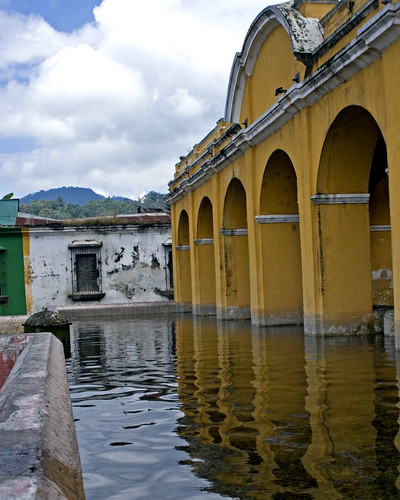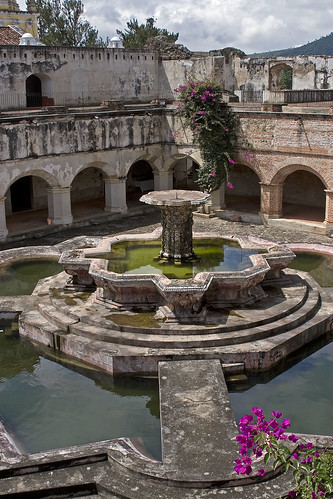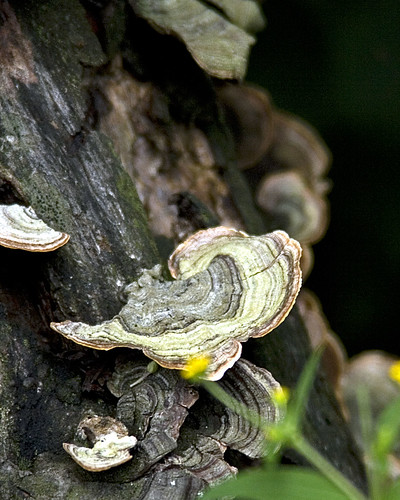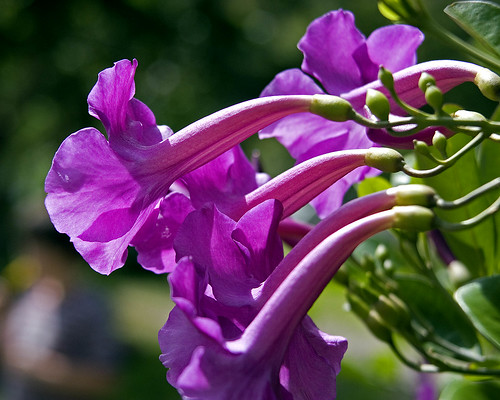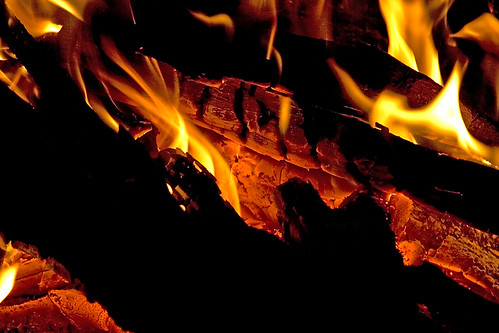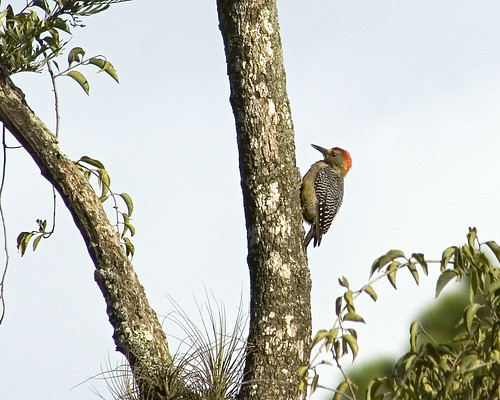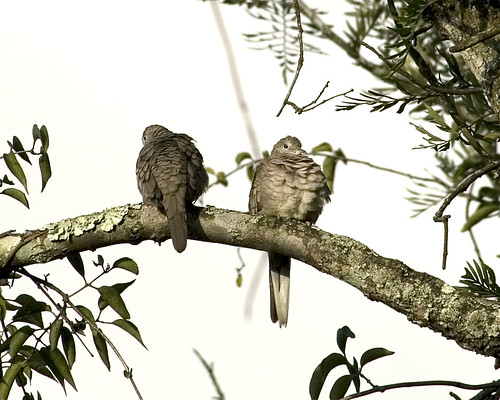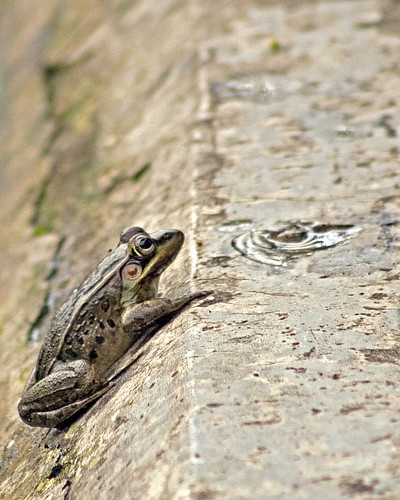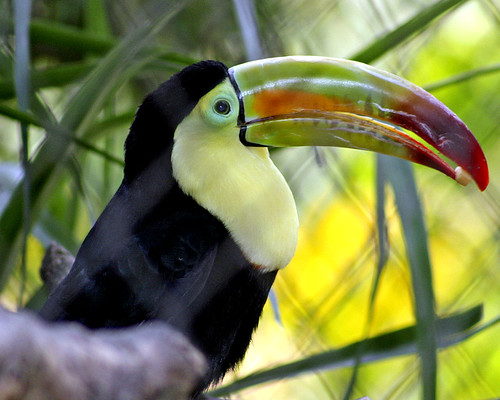volcano located in Guatemala that has been inactive since the mid 16th century. At 3,760 metres, Agua volcano towers more than 3,500 metres above the Pacific coastal plain to the south and 2,000 metres above the Guatemalan highlands to the north. It dominates the local landscape except when hidden by cloud cover. The volcano is within 5 to 10 kilometres of Antigua Guatemala and several other large towns situated on its northern apron. These towns have a combined population of nearly 100,000. It is within about 20 km of Escuintla (population, ca .100,000) to the south. Coffee is grown on the volcano's lower slopes.
The local Cakchikel people have always called the volcano Hunapú "place of flowers". The Spanish conquistadors also called it Hunapú until a mudflow from the volcano in 1541 destroyed the original capital of Guatemala (now known as Ciudad Vieja) and the city was moved to the current Antigua Guatemala following this disaster. As the lahar produced a destructive flood of water, this prompted the modern name "Volcán de Agua" meaning "Volcano of Water", in contrast to the nearby "Volcán de Fuego" or "Volcano of Fire". The Cakchikels call Volcan de Fuego Chi Gag, which translates to "where the fire is".
Though the volcano has not been active since the mid 16th century, it has the potential to produce debris flows (watery flows of mud, rock, and debris — also known as lahars when they occur on a volcano) that could inundate these nearby populated areas.
martes, 12 de febrero de 2008
HUNAPU (Volcan de Agua)
Fray BARTOLOME DE LAS CASAS - La Merced
"No y mil veces no, ¡paz en todas partes y para todos los hombres, paz sin diferencia de raza! Sólo existe un Dios, único y verdadero para todos los pueblos, indios, paganos, griegos y bárbaros. Por todos sufrió muerte y suplicio." Fray Bartolomé de Las Casas 1,563
"No and a thousand times no, peace everywhere and for all men, peace without racial distinctions! There is only one GOD, unique and true for all people, indian, pagan, greek and barbarian. For all, HE suffered death and suplice". Fray Bartolomé de las Casas, 1,563
AMATITLAN
Lake Amatitlan is located in the departmental jurisdiction of Guatemala, between the municipalities of Amatitlán, Petapa and Villa Canales. The lake has an extension of 15 square kilometers. The lake seats 1,188 meters above sea level and its geographical coordinates are lat. 14°27'50" North , long 90°36’10” West.
The lake suffered heavy pollution from Guatemala city and other urban and industrial areas. Currently, it is undergoing arecovery process, with positive results so far.
Monumento a Santiago Apóstol - Cerro de la Cruz, Antigua Guatemala
Saint James monument on the Hill of the Cross, Antigua Guatemala.
La Antigua Guatemala (commonly referred to as just Antigua or La Antigua) is a city in the central highlands of Guatemala famous for its well-preserved Spanish Mudéjar-influenced Baroque architecture as well as a number of spectacular ruined churches. It has been designated a UNESCO World Heritage Site.
Antigua Guatemala serves as the municipal seat for the surrounding municipality of the same name. It also serves as the departmental capital of Sacatepéquez Department.
La Antigua Guatemala means the "Old Guatemala" and was the third capital of Guatemala. The first capital of Guatemala was founded on the site of a Cakchiquel-Maya city, now called Iximche, on July 25, 1524 -the day of Saint James- and called La Muy Noble y Muy Leal Ciudad de los Caballeros de Santiago de Goathemalan (The Very Noble and Very Loyal City of the Knights of Saint James of Guatemala). Naturally, St. James became the patron saint of the city. After several Cakchiquel uprisings, the capital was moved to a more suitable site in the Valley of Almolonga on November 22, 1527, and kept its original name. When this city, now named Ciudad Vieja, was destroyed by a flood, the authorities decided to move once more, this time to the Valley of Panchoy. So, on March 10, 1543 the Spanish conquistadors founded present-day Antigua, and again, it was named Santiago de los Caballeros. For more than 200 years it served as the seat of the military governor of the Spanish colony of Guatemala, a large region that included almost all of present-day Central America and the five southernmost States of Mexico: Chiapas, Tabasco, Campeche, Yucatán, and Quintana Roo. In 1566 King Felipe II of Spain gave it the title of"Muy Noble y Muy Leal" ("Very Noble and Very Loyal").
In 1773, a series of earthquakes destroyed much of the town, which led to the third change in location for the city. The Spanish Crown ordered (1776) the removal of the capital to a safer location, the Valley of the Shrine, where Guatemala City, the modern capital of Guatemala, now stands. This new city did not retain its old name and was christened Nueva Guatemala de la Asunción (New Guatemala of the Ascension) and its patron saint is Our Lady of Ascension. The badly damaged city of Santiago de los Caballeros was ordered abandoned, although not everyone left, and was referred to as la Antigua Guatemala, or Old Guatemala.
Antigua Guatemala - SANTA CLARA Church
La Antigua Guatemala (commonly referred to as just Antigua or La Antigua) is a city in the central highlands of Guatemala famous for its well-preserved Spanish Mudéjar-influenced Baroque architecture as well as a number of spectacular ruined churches. It has been designated a UNESCO World Heritage Site.
Antigua Guatemala serves as the municipal seat for the surrounding municipality of the same name. It also serves as the departmental capital of Sacatepéquez Department.
La Antigua Guatemala means the "Old Guatemala" and was the third capital of Guatemala. The first capital of Guatemala was founded on the site of a Cakchiquel-Maya city, now called Iximche, on July 25, 1524 -the day of Saint James- and called La Muy Noble y Muy Leal Ciudad de los Caballeros de Santiago de Goathemalan (The Very Noble and Very Loyal City of the Knights of Saint James of Guatemala). Naturally, St. James became the patron saint of the city. After several Cakchiquel uprisings, the capital was moved to a more suitable site in the Valley of Almolonga on November 22, 1527, and kept its original name. When this city, now named Ciudad Vieja, was destroyed by a flood, the authorities decided to move once more, this time to the Valley of Panchoy. So, on March 10, 1543 the Spanish conquistadors founded present-day Antigua, and again, it was named Santiago de los Caballeros. For more than 200 years it served as the seat of the military governor of the Spanish colony of Guatemala, a large region that included almost all of present-day Central America and the five southernmost States of Mexico: Chiapas, Tabasco, Campeche, Yucatán, and Quintana Roo. In 1566 King Felipe II of Spain gave it the title of"Muy Noble y Muy Leal" ("Very Noble and Very Loyal").
In 1773, a series of earthquakes destroyed much of the town, which led to the third change in location for the city. The Spanish Crown ordered (1776) the removal of the capital to a safer location, the Valley of the Shrine, where Guatemala City, the modern capital of Guatemala, now stands. This new city did not retain its old name and was christened Nueva Guatemala de la Asunción (New Guatemala of the Ascension) and its patron saint is Our Lady of Ascension. The badly damaged city of Santiago de los Caballeros was ordered abandoned, although not everyone left, and was referred to as la Antigua Guatemala, or Old Guatemala.
Convento de La Merced - Antigua Guatemala
La Antigua Guatemala (commonly referred to as just Antigua or La Antigua) is a city in the central highlands of Guatemala famous for its well-preserved Spanish Mudéjar-influenced Baroque architecture as well as a number of spectacular ruined churches. It has been designated a UNESCO World Heritage Site.
Antigua Guatemala serves as the municipal seat for the surrounding municipality of the same name. It also serves as the departmental capital of Sacatepéquez Department.
La Antigua Guatemala means the "Old Guatemala" and was the third capital of Guatemala. The first capital of Guatemala was founded on the site of a Cakchiquel-Maya city, now called Iximche, on July 25, 1524 -the day of Saint James- and called La Muy Noble y Muy Leal Ciudad de los Caballeros de Santiago de Goathemalan (The Very Noble and Very Loyal City of the Knights of Saint James of Guatemala). Naturally, St. James became the patron saint of the city. After several Cakchiquel uprisings, the capital was moved to a more suitable site in the Valley of Almolonga on November 22, 1527, and kept its original name. When this city, now named Ciudad Vieja, was destroyed by a flood, the authorities decided to move once more, this time to the Valley of Panchoy. So, on March 10, 1543 the Spanish conquistadors founded present-day Antigua, and again, it was named Santiago de los Caballeros. For more than 200 years it served as the seat of the military governor of the Spanish colony of Guatemala, a large region that included almost all of present-day Central America and the five southernmost States of Mexico: Chiapas, Tabasco, Campeche, Yucatán, and Quintana Roo. In 1566 King Felipe II of Spain gave it the title of"Muy Noble y Muy Leal" ("Very Noble and Very Loyal").
In 1773, a series of earthquakes destroyed much of the town, which led to the third change in location for the city. The Spanish Crown ordered (1776) the removal of the capital to a safer location, the Valley of the Shrine, where Guatemala City, the modern capital of Guatemala, now stands. This new city did not retain its old name and was christened Nueva Guatemala de la Asunción (New Guatemala of the Ascension) and its patron saint is Our Lady of Ascension. The badly damaged city of Santiago de los Caballeros was ordered abandoned, although not everyone left, and was referred to as la Antigua Guatemala, or Old Guatemala.
Convento de Santa Clara - Antigua Guatemala
La Antigua Guatemala (commonly referred to as just Antigua or La Antigua) is a city in the central highlands of Guatemala famous for its well-preserved Spanish Mudéjar-influenced Baroque architecture as well as a number of spectacular ruined churches. It has been designated a UNESCO World Heritage Site.
Antigua Guatemala serves as the municipal seat for the surrounding municipality of the same name. It also serves as the departmental capital of Sacatepéquez Department.
La Antigua Guatemala means the "Old Guatemala" and was the third capital of Guatemala. The first capital of Guatemala was founded on the site of a Cakchiquel-Maya city, now called Iximche, on July 25, 1524 -the day of Saint James- and called La Muy Noble y Muy Leal Ciudad de los Caballeros de Santiago de Goathemalan (The Very Noble and Very Loyal City of the Knights of Saint James of Guatemala). Naturally, St. James became the patron saint of the city. After several Cakchiquel uprisings, the capital was moved to a more suitable site in the Valley of Almolonga on November 22, 1527, and kept its original name. When this city, now named Ciudad Vieja, was destroyed by a flood, the authorities decided to move once more, this time to the Valley of Panchoy. So, on March 10, 1543 the Spanish conquistadors founded present-day Antigua, and again, it was named Santiago de los Caballeros. For more than 200 years it served as the seat of the military governor of the Spanish colony of Guatemala, a large region that included almost all of present-day Central America and the five southernmost States of Mexico: Chiapas, Tabasco, Campeche, Yucatán, and Quintana Roo. In 1566 King Felipe II of Spain gave it the title of"Muy Noble y Muy Leal" ("Very Noble and Very Loyal").
In 1773, a series of earthquakes destroyed much of the town, which led to the third change in location for the city. The Spanish Crown ordered (1776) the removal of the capital to a safer location, the Valley of the Shrine, where Guatemala City, the modern capital of Guatemala, now stands. This new city did not retain its old name and was christened Nueva Guatemala de la Asunción (New Guatemala of the Ascension) and its patron saint is Our Lady of Ascension. The badly damaged city of Santiago de los Caballeros was ordered abandoned, although not everyone left, and was referred to as la Antigua Guatemala, or Old Guatemala.
Tanque de Agua La Unión - Antigua Guatemala
La Antigua Guatemala (commonly referred to as just Antigua or La Antigua) is a city in the central highlands of Guatemala famous for its well-preserved Spanish Mudéjar-influenced Baroque architecture as well as a number of spectacular ruined churches. It has been designated a UNESCO World Heritage Site.
Antigua Guatemala serves as the municipal seat for the surrounding municipality of the same name. It also serves as the departmental capital of Sacatepéquez Department.
La Antigua Guatemala means the "Old Guatemala" and was the third capital of Guatemala. The first capital of Guatemala was founded on the site of a Cakchiquel-Maya city, now called Iximche, on July 25, 1524 -the day of Saint James- and called La Muy Noble y Muy Leal Ciudad de los Caballeros de Santiago de Goathemalan (The Very Noble and Very Loyal City of the Knights of Saint James of Guatemala). Naturally, St. James became the patron saint of the city. After several Cakchiquel uprisings, the capital was moved to a more suitable site in the Valley of Almolonga on November 22, 1527, and kept its original name. When this city, now named Ciudad Vieja, was destroyed by a flood, the authorities decided to move once more, this time to the Valley of Panchoy. So, on March 10, 1543 the Spanish conquistadors founded present-day Antigua, and again, it was named Santiago de los Caballeros. For more than 200 years it served as the seat of the military governor of the Spanish colony of Guatemala, a large region that included almost all of present-day Central America and the five southernmost States of Mexico: Chiapas, Tabasco, Campeche, Yucatán, and Quintana Roo. In 1566 King Felipe II of Spain gave it the title of"Muy Noble y Muy Leal" ("Very Noble and Very Loyal").
In 1773, a series of earthquakes destroyed much of the town, which led to the third change in location for the city. The Spanish Crown ordered (1776) the removal of the capital to a safer location, the Valley of the Shrine, where Guatemala City, the modern capital of Guatemala, now stands. This new city did not retain its old name and was christened Nueva Guatemala de la Asunción (New Guatemala of the Ascension) and its patron saint is Our Lady of Ascension. The badly damaged city of Santiago de los Caballeros was ordered abandoned, although not everyone left, and was referred to as la Antigua Guatemala, or Old Guatemala.
Convento de Santa Clara - Antigua Guatemala
La Antigua Guatemala (commonly referred to as just Antigua or La Antigua) is a city in the central highlands of Guatemala famous for its well-preserved Spanish Mudéjar-influenced Baroque architecture as well as a number of spectacular ruined churches. It has been designated a UNESCO World Heritage Site.
Antigua Guatemala serves as the municipal seat for the surrounding municipality of the same name. It also serves as the departmental capital of Sacatepéquez Department.
La Antigua Guatemala means the "Old Guatemala" and was the third capital of Guatemala. The first capital of Guatemala was founded on the site of a Cakchiquel-Maya city, now called Iximche, on July 25, 1524 -the day of Saint James- and called La Muy Noble y Muy Leal Ciudad de los Caballeros de Santiago de Goathemalan (The Very Noble and Very Loyal City of the Knights of Saint James of Guatemala). Naturally, St. James became the patron saint of the city. After several Cakchiquel uprisings, the capital was moved to a more suitable site in the Valley of Almolonga on November 22, 1527, and kept its original name. When this city, now named Ciudad Vieja, was destroyed by a flood, the authorities decided to move once more, this time to the Valley of Panchoy. So, on March 10, 1543 the Spanish conquistadors founded present-day Antigua, and again, it was named Santiago de los Caballeros. For more than 200 years it served as the seat of the military governor of the Spanish colony of Guatemala, a large region that included almost all of present-day Central America and the five southernmost States of Mexico: Chiapas, Tabasco, Campeche, Yucatán, and Quintana Roo. In 1566 King Felipe II of Spain gave it the title of"Muy Noble y Muy Leal" ("Very Noble and Very Loyal").
In 1773, a series of earthquakes destroyed much of the town, which led to the third change in location for the city. The Spanish Crown ordered (1776) the removal of the capital to a safer location, the Valley of the Shrine, where Guatemala City, the modern capital of Guatemala, now stands. This new city did not retain its old name and was christened Nueva Guatemala de la Asunción (New Guatemala of the Ascension) and its patron saint is Our Lady of Ascension. The badly damaged city of Santiago de los Caballeros was ordered abandoned, although not everyone left, and was referred to as la Antigua Guatemala, or Old Guatemala.
Convento de La Merced - Antigua Guatemala
La Antigua Guatemala (commonly referred to as just Antigua or La Antigua) is a city in the central highlands of Guatemala famous for its well-preserved Spanish Mudéjar-influenced Baroque architecture as well as a number of spectacular ruined churches. It has been designated a UNESCO World Heritage Site.
Antigua Guatemala serves as the municipal seat for the surrounding municipality of the same name. It also serves as the departmental capital of Sacatepéquez Department.
La Antigua Guatemala means the "Old Guatemala" and was the third capital of Guatemala. The first capital of Guatemala was founded on the site of a Cakchiquel-Maya city, now called Iximche, on July 25, 1524 -the day of Saint James- and called La Muy Noble y Muy Leal Ciudad de los Caballeros de Santiago de Goathemalan (The Very Noble and Very Loyal City of the Knights of Saint James of Guatemala). Naturally, St. James became the patron saint of the city. After several Cakchiquel uprisings, the capital was moved to a more suitable site in the Valley of Almolonga on November 22, 1527, and kept its original name. When this city, now named Ciudad Vieja, was destroyed by a flood, the authorities decided to move once more, this time to the Valley of Panchoy. So, on March 10, 1543 the Spanish conquistadors founded present-day Antigua, and again, it was named Santiago de los Caballeros. For more than 200 years it served as the seat of the military governor of the Spanish colony of Guatemala, a large region that included almost all of present-day Central America and the five southernmost States of Mexico: Chiapas, Tabasco, Campeche, Yucatán, and Quintana Roo. In 1566 King Felipe II of Spain gave it the title of"Muy Noble y Muy Leal" ("Very Noble and Very Loyal").
In 1773, a series of earthquakes destroyed much of the town, which led to the third change in location for the city. The Spanish Crown ordered (1776) the removal of the capital to a safer location, the Valley of the Shrine, where Guatemala City, the modern capital of Guatemala, now stands. This new city did not retain its old name and was christened Nueva Guatemala de la Asunción (New Guatemala of the Ascension) and its patron saint is Our Lady of Ascension. The badly damaged city of Santiago de los Caballeros was ordered abandoned, although not everyone left, and was referred to as la Antigua Guatemala, or Old Guatemala.
Toucan
Guatemalan toucan, photo taken in Zoologico La Aurora, Guatemala City on December 2006.
According to Wikipedia.com: "Toucans are near passerine birds from the neotropics, most closely related to American barbets. They are brightly marked and have large, colorful bills. The family includes five genera and about forty different species. The name of this bird group is derived from Tupi tucana, via French."
Buzzard
South American Buzzard, photo taken on Casablanca, Ecuador in December 2007.
Buitre Sur Americano, foto tomada en Casablanca, Ecuador en Diciembre 2007


